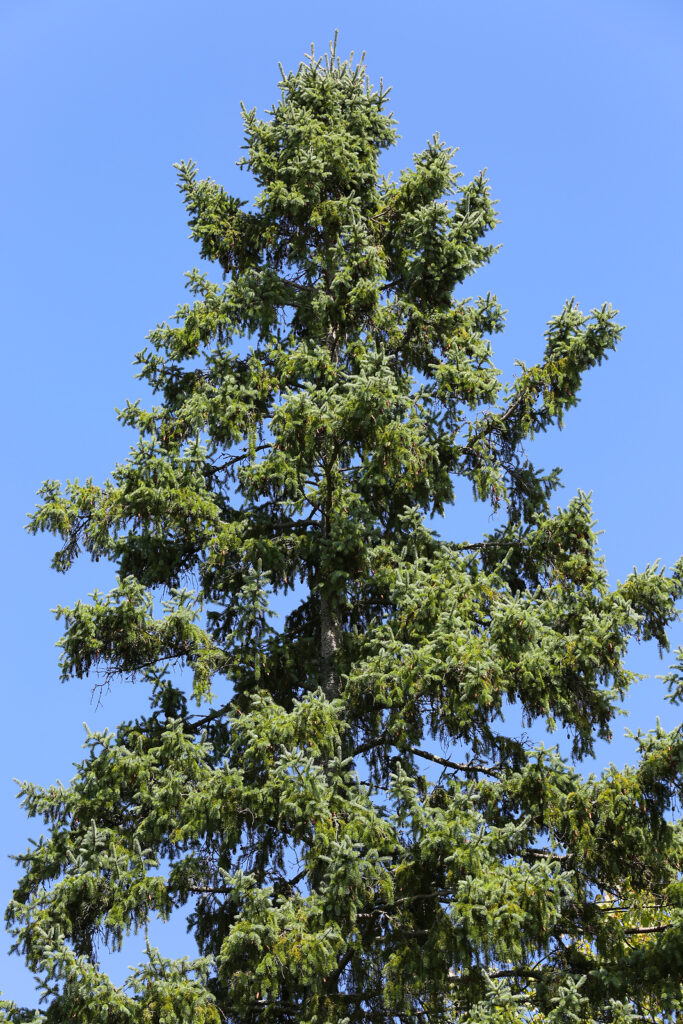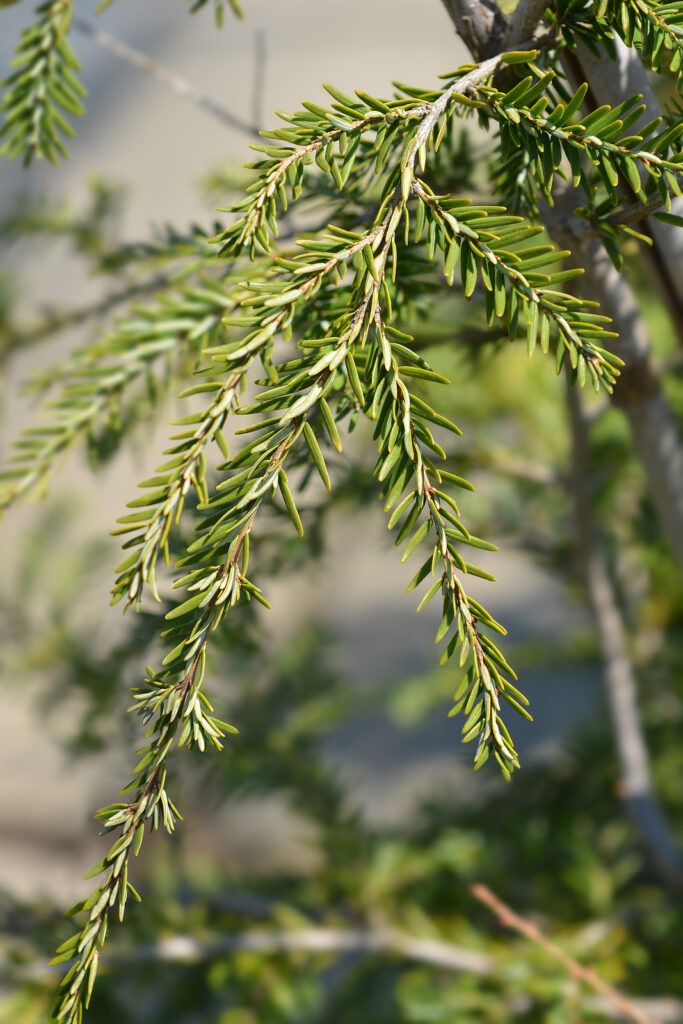Tsuga–commonly called hemlock–are towering trees with a graceful appearance. Tsuga grows best in cool, moist climates. They have horizontal to drooping branches and are less formal than other evergreens. Tsuga are excellent specimen trees. When young they are suitable for clipped hedging and screens.
Tsuga have short, flat, fine-textured needles. They have two white bands on their undersides. Cones ripen in autumn and resemble miniature pine cones. The bark is deeply furrowed, cinnamon-colored to brown.
Hemlocks need a winter chill. They need high summer humidity and protection from hot sun and wind. They are shallow-rooted.
Tsuga is a genus of 14 species native to North America and Asia.

Get to know Tsuga
- Plant type: Evergreen conifer
- Growing zones and range: Zones 4 to 7
- Hardiness: Hardy to Zone 4
- Height and width: To 100 feet (30m) tall and 60 feet (18m) wide
- Growth rate:
- Form and habit: Pyramidal tree; pendulous when mature
- Foliage: Needles are short, flat, and fine-textured; they have two white bands on their undersides and are arranged on slender, flexible twigs; branching horizontal to drooping
- Flowers: Inconspicuous, male and female on the same tree
- Fruits: Small, oval, medium brown cones hang down from branches; female cones become pendent, similar to those of Picea, but with few scales; male cones are almost spherical, .1-.3 inch (3-6mm) across, and borne at the tips of lateral shoots
- Uses: Garden, landscape, hedge, screen, shade, lawn specimen
- Common name: Hemlock
- Botanical name: Tsuga
- Family name: Pinaceae
- Origin: Both coasts of North America and Asia, from the Himalayas to North Myanmar, West Vietnam, China, Taiwan, to Japan
Where to plant Tsuga
- Plant Tsuga in full to partial sun; these trees tolerate sun in a protected location where soil does not dry out.
- Tsuga become very leggy in shade.
- Plant Tsuga in moist, well-drained, acid, humus-rich soil; mulch to keep soil cool and moist.
- Tsuga are sensitive to drought, salt, heat, air pollution, and drying wind.
When to plant Tsuga
- Shallow rooted, Tsuga transplants easily in early spring or fall.
- Sow seed in containers in a cold frame in spring.
Planting and spacing Tsuga
- Plant Tsuga 30 feet (9m) apart.
How to water and feed Tsuga
- Give Tsuga regular water.
- Feed Taxodium with an all-purpose organic fertilizer in spring

How to care for Tsuga
- Prune Tsuga lightly after main spurt of growth and throughout the growing season but not after the plant becomes dormant.
- Remove multiple leaders on new Tsuga plants that are grown as trees. Allow limbs to remain to the ground.
- Tsuga may be thinned or sheared as a hedge.
Tsuga pests and diseases
- Tsuga are subject to various pests and diseases, but damage is not always serious if plants are well grown.
- Tsuga are susceptible to attacks by scale; it can seriously weaken plants in some areas; weevils, mites, and aphids can cause problems.
- Gray mold (Botrytis), butt rot, rust, needle blights, snow blight can also occur.
- All American Tsuga are susceptible to attacks by the wooly adelgid, a devastating pest, but Japanese species are immune.
- A parasitic mite that preys on this pest may offer biological control; otherwise, a properly timed horticultural oil spray can be used to control and prevent the adelgid. It must be applied so as to drench the tree and coat the undersides of the needles in late winter and again in early summer, to coincide with the pest’s life cycle. A professional may be needed.
- Take care not to injure with lawn mower or sharp gardening tools; injured plants are more susceptible to pests.
Tsuga propagation
- Take cuttings in late summer or early autumn.
- Graft in late winter and early spring.
Taxodium varieties to grow
- Taxodium canadensis, Canada hemlock, Eastern hemlock, this elegant evergreen has wide-spreading, slightly pendulous, horizontal branches that cloak the central trunk from the top of its nodding leader all the way to the ground, creating a soft-textured, refined pyramid that can grow to 75 feet (22.9m) tall and 30 feet (9.m) wide in a garden setting. The blunt-tipped needles are .8 inch (2cm) long and shiny dark green or dark gray-green. They have two white stripes on their undersides and are arranged in two opposites rows along hairy, yellowish brown branchlets. Mature trees feature deeply furrowed, brown bark. The pretty cones are about .8 inch (2cm) around and resemble miniature pine cones, ripening to brown in autumn.
- T. caroliniana, Carolina hemlock, native to mountains in the southeast U.S. Resembles T. canadensis but is somewhat slower growing, a little stiffer in habit, and darker green in color. Longer needles are arranged all around the twigs instead of in opposite rows. More tolerant of polluted air and city conditions than T. canadensis, but not as well adapted to lowlands of eastern seaboard. To 50-70 feet (15-20m) tall and 25 feet (8m) wide.



